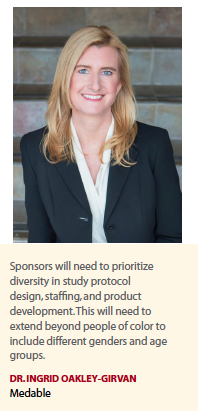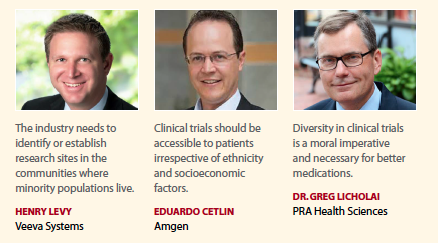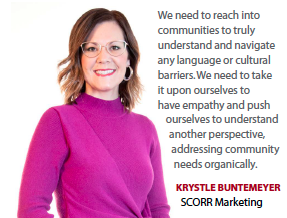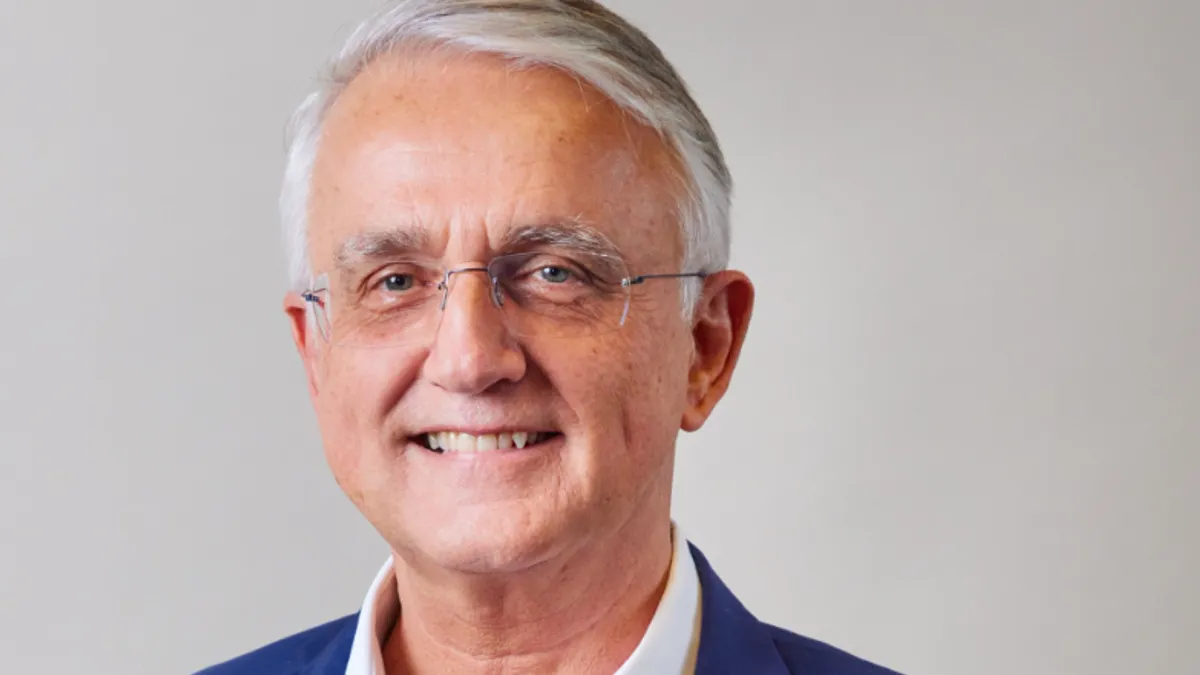In recent years, pharma and biotech companies have become more aware of the lack of representation of certain demographics in clinical trials and its resulting ramifications. Although the participation of women in clinical trials has improved in recent years, the participation of racial and ethnic minority groups continues to lag far behind.
One of the biggest drawbacks to low clinical trial participation from Black, indigenous, and people of color (BIPOC) communities is the lack of data on how certain diseases and therapeutics affect these communities. For example, data show certain types of cancers, including multiple myeloma and prostate cancer, to be far more prevalent in Black communities. Yet, there is not much data on how biological differences could play a role in determining efficacy of drugs to treat these cancers.
 According to JAMA Oncology, a review of 230 oncology trials conducted over 10 years showed race was only reported in 63% of them, and in those trials, Blacks and Hispanics were underrepresented relative to their proportion among the U.S. cancer population. Whites represented 98% of expected proportion, while Hispanics represented 44% and Blacks only 22% of expected proportion.
According to JAMA Oncology, a review of 230 oncology trials conducted over 10 years showed race was only reported in 63% of them, and in those trials, Blacks and Hispanics were underrepresented relative to their proportion among the U.S. cancer population. Whites represented 98% of expected proportion, while Hispanics represented 44% and Blacks only 22% of expected proportion.
Trials focused on COVID-19, which is disproportionately affecting the Black community, are also having issues around diversity. A study found only a few trials are tracking the demographics of participants, and that Black patients were underrepresented in all studies relative to the affected population in the cities in which the studies took place.
“Diversity in clinical trials is a moral imperative and necessary for better medications," says Greg Licholai, M.D., chief medical information officer of PRA Health Sciences. “The way diseases present and respond to drugs vary greatly by gender, race, and ethnicity."
For example, Dr. Licholai notes, one study showed the blood thinner clopidogrel is only as effective as a placebo in 75% of Pacific Islanders, whose bodies don’t produce the enzyme required to activate the drug.
“We have an obligation as an industry to ensure that clinical trials are not a privileged opportunity for a small group of people, but are a care option available for all patients, regardless of age, gender, ethnic or racial backgrounds, or geographic location," Dr. Licholai says.
In recent years, the FDA has made a point of encouraging pharma and biotech companies to increase clinical trial diversity. The agency issued a June 2019 draft guidance on enhancing diversity in clinical trials complete with guidance for modifying eligibility criteria, enrollment practices, and trial designs. Among its recommendations are to broaden eligibility criteria in enriched clinical trials, make trial participation less of a burden for patients through mechanisms like decentralized clinical trials, and adopt enrollment and retention practices that enhance inclusiveness.
Pharma’s Progress
 Pharma and biotech companies are taking these recommendations to heart, with many having taken concrete steps to help rectify the racial inequities in their clinical trials. For example, in December 2018 Amgen donated $2 million to Lazarex Cancer Foundation’s Improving Patient Access to Cancer Clinical Trials (IMPACT) program designed to improve patient enrollment and retention, minority participation, and equitable access in oncology trials. IMPACT began as a pilot program with Massachusetts General Hospital and has expanded to include 20 top cancer centers and public health programs nationwide. The Mass Gen pilot program recorded a 29% increase in overall participation, and most significantly, minority participation in cancer clinical trials doubled.
Pharma and biotech companies are taking these recommendations to heart, with many having taken concrete steps to help rectify the racial inequities in their clinical trials. For example, in December 2018 Amgen donated $2 million to Lazarex Cancer Foundation’s Improving Patient Access to Cancer Clinical Trials (IMPACT) program designed to improve patient enrollment and retention, minority participation, and equitable access in oncology trials. IMPACT began as a pilot program with Massachusetts General Hospital and has expanded to include 20 top cancer centers and public health programs nationwide. The Mass Gen pilot program recorded a 29% increase in overall participation, and most significantly, minority participation in cancer clinical trials doubled.
“The promise of the medicines that we make is only relevant if we are able to generate the safety and efficacy information needed to obtain regulatory approval of those medicines," says Eduardo Cetlin, Amgen’s executive director, philanthropy and responsibility. “Clinical trials should be accessible to patients irrespective of ethnicity and socioeconomic factors, and Lazarex offers a valuable and effective forum to offer support to patients who seek access to oncology clinical trials."
Biogen’s efforts to expand diversity include building relationships and trust within African-American and Hispanic/Latinx communities to increase representation of minority groups and underserved populations in U.S. clinical trials. As part of this effort, the company formed a Global Clinical Operations (GCO) UP Champions team, a group of Biogen employees who support diversity in clinical trial participation awareness and work cross-functionally within Biogen.
Biogen also is collaborating with the Center for Information and Study on Clinical Research Participation (CISCRP) and the National Minority Quality Forum (NMQF) to spur conversation and education about clinical trials with people from diverse backgrounds. In 2019, Biogen hosted booths at four NMQF community health events, where the company shared its work in expanding clinical trial diversity.
At Pfizer, development programs are required to recruit participants who are more representative of the patient populations living with the conditions under  study. Some of the company’s innovations include a real-time dashboard for anonymously tracking diversity of clinical trial participants and partnerships focused on recruiting diverse study participants. Pfizer is also educating trainee investigators on the importance of diversity and expanding its research locations to include more underserved areas.
study. Some of the company’s innovations include a real-time dashboard for anonymously tracking diversity of clinical trial participants and partnerships focused on recruiting diverse study participants. Pfizer is also educating trainee investigators on the importance of diversity and expanding its research locations to include more underserved areas.
A Question of Trust
Those who conduct clinical trials face a number of challenges when it comes to broadening diversity. A study published in the journal Current Problems in Cardiology identified five critical barriers to clinical trial participation by racially and ethnically diverse patients: mistrust, lack of comfort with the clinical trial process, lack of information about clinical trials, time and resource constraints associated with participation, and lack of awareness about the existence and importance of clinical trials.
Krystle Buntemeyer, president of SCORR Marketing, notes that “a wide-ranging educational component on the value trial participation brings to patients" is the first step to closing the demographic gap in clinical trials.
“To focus on reaching a more diverse population, that education needs to be very specific, authentic, and compassionate," Ms. Buntemeyer says. “That’s because trust has been a tremendous barrier in reaching underserved communities. It’s going to take time — and dedicated effort — to overcome that mistrust."
The lack of trust she speaks of stems in part from years of abuses of BIPOC communities by the U.S. medical system. Some of the more notorious examples include the decades-long Tuskegee syphilis study, in which Black men were studied without their consent and not given proper treatment for their illness; and the 1970s-era violation of thousands of poor women and women of color who were sterilized without being fully informed about the surgical procedure being performed on them and its physical and psychological impacts.
This history, along with economic and logistical barriers, has made BIPOC communities understandably reluctant to voluntarily participate in a clinical trial process. But there are ways to address these concerns in a sensitive, thoughtful, productive manner.
According to the Current Problems in Cardiology study, the solutions that best resonated with surveyed patients, doctors, and clinical trial investigators and coordinators addressed three categories: mistrust, including lack of information about and comfort with the research process; logistical barriers such as time and resource constraints; and limited clinical trial awareness.
The study observed that one way to address this mistrust of the research community was through communications and partnerships with trusted individuals and community groups in an effective, transparent, and culturally appropriate manner.
Steve Smith, WCG’s president, patient advocacy, says the industry must recognize that the healthcare system isn’t trusted and accessed by racial and ethnic minority communities in the same way.
“We encourage the industry to find out the facts and take note of what the experts do who work to gain trust every day, then emulate them," Mr. Smith says. “That includes demonstrating basic cultural competence in communication between physician or healthcare worker and patient, and in approaches to communities."
“Building trust takes time," Ms. Buntemeyer says. “It takes staying committed to removing these barriers through education — not only patient education, but our own education; through reaching people where they are; and through truly understanding others’ cultures and needs and responding accordingly. It’s not an easy solution, and it’s not a quick one. But it’s the right one."
Saving Time and Money
BIPOC communities are often concerned with the financial and logistical considerations of clinical trial participation, despite the fact that sponsors and/or insurers usually cover costs. The Current Problems in Cardiology study noted that some solutions that helped allay the concerns of patients and investigators included providing appropriate compensation for trial participation, transportation to and from the trial site, and flexible hours for patients. They also appreciated mobile technology such as support apps for those with smart phones and cellphones for those who had none. All of these solutions make the trial more patient-centric, which then increases the trust factor as well.
“The industry can also show good faith by recognizing participants are individuals with families, jobs, responsibilities, and worries," says Zach Hales, product manager – ClinCard at Greenphire. “During this pandemic, more than ever, there are additional stresses, including the financial. We need to recognize what might make patients feel more comfortable and implement these solutions.
“If mass transportation might be an issue because of COVID-19, offer your patients a complimentary and safe rideshare service," Mr. Hales continues. “If paying upfront for childcare, gas, and other incidentals may inhibit participation, tools such as immediate digital reimbursement can eliminate this problem."
Another barrier to BIPOC participation in a clinical trial is a lack of information about the trial and a lack of awareness about its value. The Current Problems in Cardiology study emphasized the importance of making sure all key stakeholders involved in the clinical trial — patients, physicians, and investigators alike — understand and are comfortable with the process and fully comprehend its importance.
 “We need to reach into communities to truly understand and navigate any language or cultural barriers," Ms. Buntemeyer says. “We need to take it upon ourselves to have empathy and push ourselves to understand another perspective, addressing community needs organically — not just by inserting ourselves into the conversation, but by listening first, responding appropriately, and then taking impactful action."
“We need to reach into communities to truly understand and navigate any language or cultural barriers," Ms. Buntemeyer says. “We need to take it upon ourselves to have empathy and push ourselves to understand another perspective, addressing community needs organically — not just by inserting ourselves into the conversation, but by listening first, responding appropriately, and then taking impactful action."
Experts agree that one way to truly convey understanding of the issues and concerns of BIPOC communities is to make sure those communities are represented on the investigator side as well as the patient and physician side.
“Sponsors need to prioritize diversity in study protocol design, staffing, and product development," says Ingrid Oakley-Girvan, Ph.D., senior VP of research and strategy at Medable. “This will need to extend beyond people of color to include different genders and age groups. Sponsors, sites, and CROs will need to involve patients from all backgrounds in the study process from the start."
Dr. Oakley-Girvan notes that Medable’s Patient Advocacy Council (PAC) consists of male and female patients of different ethnicities ranging in age from 20 to mid-70s, and that Medable is working to expand the PAC to include minorities.
“The PAC informs Medable products and trial design — not on the back end, but at the beginning when they can make the biggest impact," she says.
According to Christian Rubio, VP, strategic advancement at Global Genes, employing people from diverse backgrounds with firsthand connections and experience with the healthcare system can ensure that trials will be designed for access by people from underserved communities.
“It’s not just about being culturally competent in your communications; trust is built when there’s cultural congruence between patients, trial designers, site operators, and the clinical teams supporting them," Mr. Rubio says. “It’s a long-term commitment to building the relationships you have to foster — from the science to the personal connections you make — and then you can start to talk about the need to be a part of a trial."
“One of the most challenging obstacles is a lack of information presented in a place and a way that communities will encounter it, trust it, and absorb it," Mr. Smith says. “That means our industry must focus on not using materials that show only Caucasian patients to African- American or Hispanic families. That means we must use language in culturally competent ways to communicate and interact.
“Competency training is helpful," he continues. “Working with African-American or Hispanic physicians, nurses, and navigators is most helpful. Considering the role of churches, family gatherings, social gatherings, and community organizations is helpful. Building long-term, trust-based relationships with community opinion leaders is critical. Using psycho-social interview methods to understand a family’s needs with respect to clinical trial participation is one technique that indicates a serious approach to addressing those social determinants of living."
“The industry needs to identify or establish research sites in the communities where minority populations live," says Henry Levy, general manager, Vault CDMS, site, and patient solutions at Veeva Systems. “It is also essential that clinical leaders explore technology that can enable patient-centric approaches such as virtual visits, which expands the geographic, and therefore the demographic, reach of clinical trials."
“It’s important to commit to supporting patient advocacy organizations to enhance their cultural competency in outreach and congruence in their care networks by helping them engage community health workers, local leaders, and other trusted resources," Mr. Rubio says. “Over time, the patients and caregivers will be there if or when a trial is interrupted, continuing to drive research and discovery until there’s a treatment for all their patients."
Centering on the Patient
 Experts cite decentralized clinical trials as an ideal way to expand access to underserved communities, given the patient-centric nature of such studies.
Experts cite decentralized clinical trials as an ideal way to expand access to underserved communities, given the patient-centric nature of such studies.
“Clinical trials often have inherent barriers, particularly ones centered around site-based requirements that preclude some groups from participating," Dr. Licholai says. “Decentralized trials provide an opportunity to reduce these burdens, yet our industry has been slow to adopt these and maintains the status quo on how to conduct research."
Dr. Oakley-Girvan agrees that a decentralized research approach “will dramatically improve access by bringing the trial to the patient, removing the burdens of travel and distance to make trials feasible across demographics.
“This is not theoretical," she adds. “The National Center for Biotechnology Information (NCBI) found that a decentralized trial model recruited three times as many patients three times faster than the traditional model. Patients in the decentralized model also better represented urban and rural areas. These benefits are particularly important for rare diseases, as trials are few and far between and patients may be spread across wide geographic areas."
Dr. Licholai says to spur more widespread adoption, the industry needs to redefine what it means by decentralized trials. “Contrary to common misconceptions, decentralization doesn’t mean we virtualize everything," he notes. “Instead, decentralization can be hybrid — combining elements of traditional and virtualized trials. During protocol design, look at each trial and disease indication and ask new questions: What is the minimum number of times that patients need onsite visits? What data can be collected from home using connected devices? What other technologies can be employed, such as mobile health platforms, artificial intelligence and machine learning, or real-world evidence?
“Adopting a patient-centric mindset and becoming less reliant on site-based visits opens the door for a more diverse set of patients and ensures that new treatments work best for all the patients who use them," Dr. Licholai concludes.
“As we continue to open our eyes to social injustices across this country, more pharmaceutical companies will engage in real conversation about equality and have another important reason to embrace a decentralized approach to trials," Dr. Oakley-Girvan says. “But this is just the start. Trial sponsors will not only embrace decentralized clinical trials to expand access but will also involve more people of color in protocol development. Diversity will be first-order priority at the beginning rather than reverse-engineering racial equality into the trial design as a rescue mission."(PV)
~~~~~~~~~~~~~~~~~~~~~~~~~
Crunching the Numbers
Since 2017, the FDA’s Center for Drug Evaluation and Research (CDER) has been putting out an annual Drug Trials Snapshots Summary Report to provide transparency on clinical trial diversity. Each report shares information on the diversity of participants in the clinical trials of drugs approved by the FDA that year and provides data on the extent to which safety and efficacy data is based on demographic factors such as age, sex, race, and ethnicity.
In the Drug Trials Snapshots report issued in January 2020, CDER examined data from 46,391 patients participating in trials for 48 novel drugs and biologics approved in 2019. They found that overall, an average of 72% of subgroup participants were women, which is a significant increase from 56% in 2018.
Age-wise, an average of 36% of subgroup participants in 2019 were age 65 and older, up from 15% in 2018. This demographic does fluctuate based on the types of medications being tested each year; in 2017, those 65 and older represented an average of 32% of subgroup participants.
In terms of race and ethnicity, in 2019 an average of 72% of subgroup participants were white, up from 69% in 2018. An average of 18% were Hispanic, 9% were Asian, and 9% were Black or African-American. The Hispanic average was up from 14% in 2018, but the 2019 averages for both the Asian and Black or African-American demographics were down from 2018’s 10% and 11%, respectively.
CDER broke down the approved drugs for 2019 into four categories: hematology, oncology, neurology, and psychiatry and sleep disorders. In 2019, psychiatry and sleep disorder studies showed the largest representation of Black or African-American participation, accounting for 29% of 3,645 patients. The community also had relatively good representation in hematology trials, at 25% of 1,255 patients. By contrast, oncology showed the lowest representation of Black or African-American patients, at 4% of 3,593 patients. This poor showing in oncology is especially worrisome, given how certain cancers are far more prevalent in Black communities.
Hispanics also had scant representation in oncology trials, accounting for only 5% of patients. Hispanic participation in 2019 trials was relatively low across the board; out of 10,390 neurology patients, Hispanics represented 13%, the demographic’s highest showing. Only 8% of hematology patients and 10% of psychiatric and sleep disorder participants were Hispanic.
In terms of Asian representation, it was lowest in psychiatric and sleep disorder studies, at 6%, and highest in oncology, at 18%. Asians also accounted for 11% of hematology patients and 10% of neurology patients.















